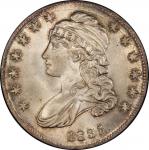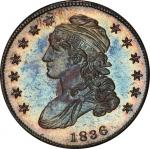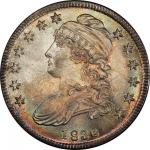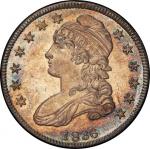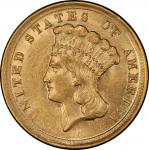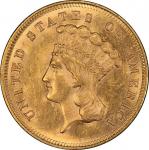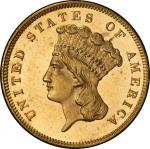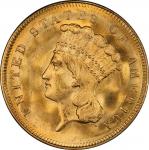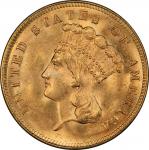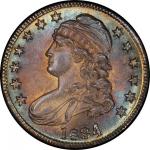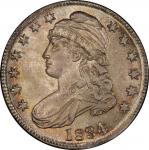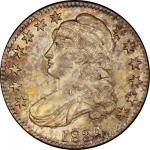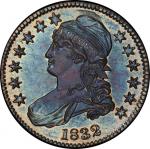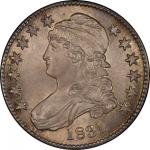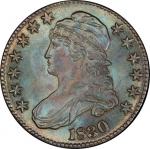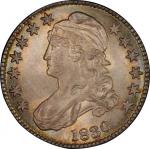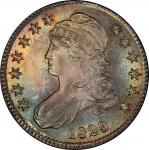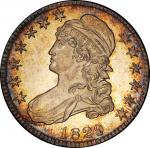“Small notes have expelled dollars and half dollars from circulation in all the states in which such notes are issued. On the other hand, dollars and half dollars abound in those states that have adopted a wiser and safer policy. Virginia, Pennsylvania, Maryland, Louisiana, and some other states, I think seven in all, do not allow their banks to issue notes under five dollars.” — The Evening Post, New York City, September 15, 1835 Toning of bright blue dappled with contrasting violet decorates the obverse, while the reverse is a more sedate and even violet gray with slate blue at the rims. Resounding with cartwheel, this piece shows a mound of frost in front of the portrait from lapping, an area that blends into the otherwise frosty surfaces. No signs of die clashing are evident, though the reverse shows some wear, a by-product of previous use as Reverse U of 1834. Its peripheral elements are pulled to the rim, but no notable cracks are present. The strike is fairly typical, with good central detail on most stars though the more rounded curls and the top of the wing at left are a bit soft. A few little marks are seen on Liberty’s portrait, but the fields are free of any significant trauma. The reverse is pristine. The concept that “bad money drives out good” is ancient, dating back to at least classical Greece, but in modern times it has come to be identified with Sir Thomas Gresham, a fiscal advisor to Queen Elizabeth I. The name “Gresham’s Law” was coined in 1858 by a Scottish economist named Henry Dunning Macleod, but Americans saw this basic tenet of monetary economics at work in their everyday life even earlier. Given the choice between keeping or spending well worn or counterfeit copper coins in the 1780s, consumers spent the “bad coins,” thereby driving the full weight, official copper coins into coin jars and dresser drawers, and thus out of circulation. The result was the Copper Panic of 1789. Given the choice between keeping or spending pre-1834 American gold coins whose intrinsic value surpassed their face value, citizens hoarded the gold or sold it at a premium to bullion dealers, thereby driving gold from circulation and creating a circulating medium that was the exclusive domain of silver coins and foreign gold coins. The result was the Act of June 28, 1834, which reduced the weight of American gold coins. In modern times, when silver was removed from dimes and quarters in 1965, coins of the old composition disappeared faster than new ones could appear, resulting in a significant coin shortage. In the mid-1830s, some Americans feared that the ratio between silver and gold had been overcorrected by the Act of 1834. If so, overvalued silver would disappear from circulation, leaving fractional denomination banknotes or scrip as the only small change. Concern that silver coins would disappear from circulation appears unfounded in hindsight, but the anxiety it caused was real at the time. Upheaval in the banking system in 1837 pushed these concerns to the back burner, though the results were the same: hoarding of specie and little hard money in circulation. Many of the Mint State half dollars of this era are probably relics of the Panic of 1837, deposited into a bank vault soon after they were struck and left there until the economic trauma subsided. While this explains why pieces in About Uncirculated and the lower reaches of Mint State are relatively common today, only serendipity can preserve a silver coin in this gem state of preservation. Only four 1835 half dollars have been graded finer than MS-65 by PCGS. The best of them, graded MS-67+, is the Eliasberg 1835 Overton-109. The other three all graded MS-65+. Of those three, one of those is the O-108 offered in the next lot, another is the O-109 offered in the November 2013 Heritage sale, and this is the last, the finest O-101 graded by PCGS. PCGS# 39927. NGC ID: 24FZ.

